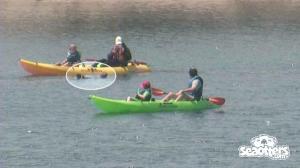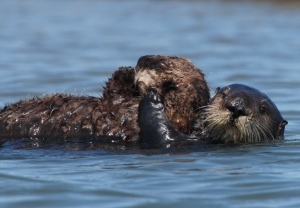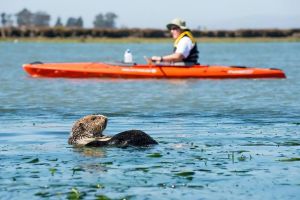Kayakers looking to get up close and personal with sea otters – and maybe snag a selfie – may unintentionally be causing harm to these beloved (and threatened) marine mammals.
When approached directly by people in the wild, sea otters often feel threatened and may dive or swim away to avoid them. This evasive maneuver can cost sea otters precious energy – energy they can only recoup by spending less time resting and more time hunting and eating.
Because portions of sea otter habitat are already at their carrying capacity, making up the lost calories can be challenging at best. and life-threatening at worst. It’s an especially big problem for nursing mother otters who are already energetically stressed by the burden of pup rearing.
In honor of Sea Otter Awareness Week, we’re bringing attention to this often-overlooked area of citizen stewardship.

Kayakers and other ocean goers like swimmers and paddleboarders likely don’t know that they’re putting sea otters at risk when they get too close, says Gena Bentall, the program coordinator of Be Sea Otter Savvy, a collaborative effort by the aquarium, U.S. Fish and Wildlife Service, California Department of Fish and Wildlife and Friends of the Sea Otter to raise awareness of sea otter disturbances by tourists.
“The cuteness of sea otters is their own detriment in a way,” Gena says. “People aren’t really going to try to approach a less charismatic species. They’re essentially loving them to death by getting too close.”

While the occasional run-in may seem trivial, a single sea otter may be forced to evade people several times a day. Gena said the cumulative effect of chronic disturbances can spell “death by a thousand cuts” for some sea otters.
According to Monterey Bay National Marine Sanctuary officials, wildlife disturbance of sea otters and other animals represents more than 40 percent of all violations recorded each year. (Disturbing sea otters and other marine mammals is a violation of federal law.)
Gena and her team are trying to quantify just how much these disturbances are costing sea otters, while also getting the word out about how to safely observe otters – from a reasonable distance.
Gena, a kayaker herself, said one of the major problems is that kayakers know too little about the consequences of approaching ocean wildlife. One major step is to have kayak rental outfits provide educational materials to all their customers. She praised one local outfitter that educates its customers in responsible behavior around the wildlife they might encounter, including putting stickers on its rental boats with tips on how to observe sea otters respectfully.

Be Sea Otter Savvy is concentrating its public awareness efforts on three hot spots where they’ve observed the most disturbance of sea otters: Elkhorn Slough in Moss Landing, Cannery Row, and Morro Bay in San Luis Obispo County.
“Our goal is to not scold people or shame people,” Gena says. “We’d rather get them to pay attention to wildlife, think about the ramifications of their behavior, and to have empathy for the animals.”
Be Sea Otter Savvy is looking for volunteers, particularly in San Luis Obispo County, to help monitor sea otter behavior and activity relative to marine recreation activities.
The best thing to do when out on the water, Gena says, is to keep your distance from sea otters as much as possible. When approaching, she adds, it’s better to float the kayak or paddleboard parallel to the animal from a safe distance, instead of paddling directly at them – a maneuver the otter may interpret as threatening. She also suggests putting the camera phone down and just being in the moment.
Learn what we’re doing to help California’s threatened sea otter population recover.

Great to know!
LikeLike
thanks:)
LikeLike